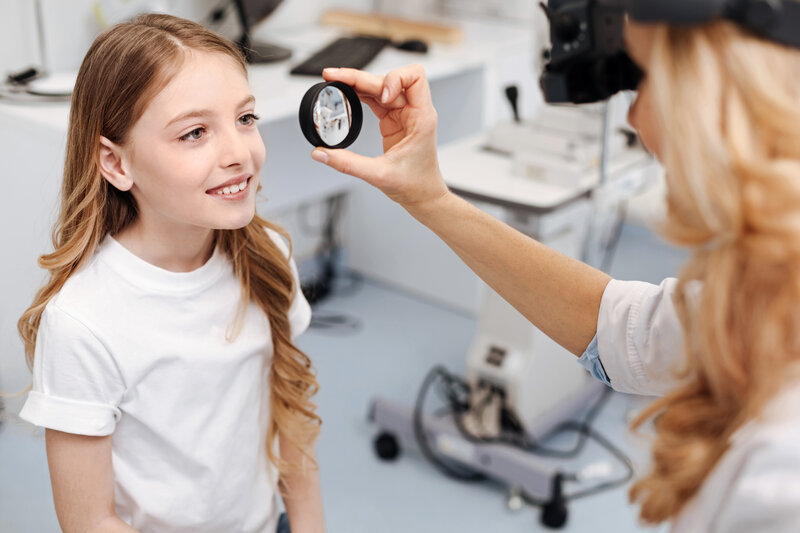What Is Vision Therapy?

Just like physical therapy improves the body’s muscle tone, strength, and coordination, vision therapy is specific to the eyes. Certain eye conditions benefit from vision therapy, which consists of a series of exercises prescribed by your optometrist.
When done as recommended, vision therapy or eye exercises strengthen eye muscles, improve the connection between the eyes and optic nerve, help the eyes work together (coordination), and can also enhance focus.
Vision Therapy Only Works For Certain Eye Conditions
Vision therapy (VT) is completely non-invasive and does not use any medications. It usually combines therapy done in an office and exercises for you or your child to do at home. It can involve a combination of treatments, depending on a patient’s diagnosis, including:
- Special lenses
- Patches
- Prisms
- Exercises
- Other therapeutic tools
The earlier vision therapy is used, the more effective it is. For example, children who need vision therapy exercises experience bigger and faster returns on their efforts. Children using VT exercises benefit from improved:
- Reading
- Learning
- Concentration
- Attention
Adults may need a bit more patience to see the results of their efforts. However, the combined effects of exercises that strengthen eye muscles and improve the connection between the eyes and the brain have positive benefits, including reduced eye strain.
If your optometrist or ophthalmologist recommends vision therapy, odds are you’ll soon notice an improvement in:
- Focus
- Reduced eye strain
- The ability to track objects in motion
- Eye comfort
- Visual concentration
The caveat is that vision therapy is only effective for particular eye or vision conditions. In cases involving reduced visual acuity (being nearsighted, farsighted, or having astigmatism), VT may help some aspects of eye coordination but does not change the diagnosis.
Six Common Eye Conditions That Benefit From VT
Here are seven of the most common eye or vision conditions treated using vision therapy.
Lazy eye (amblyopia)
Usually, a lazy eye is diagnosed early in a toddler or child’s life. In most cases, vision therapy and at-home practices (typically using a patch) are enough to correct the condition completely. When one eye wanders or shifts out of focus, the one in focus does most of the work. Over time, and without correction, the brain conserves energy and stops trying to decipher images input by the weak eye.
By working on focusing the weaker eye muscles, we also engage cooperation between both eyes and the optic nerve, eventually getting them back on track. While there may still be an acuity issue requiring glasses or contact lenses, both eyes will track together again.
Misaligned eye(s) (strabismus)
Crossed eyes are similar to a lazy eye, but both eyes are weak and have trouble focusing on a single point of vision, so they wander inward or outward as if they’re looking at the bridge of the nose.
Children and adults with misaligned eyes typically see double and may struggle with depth perception. As with a lazy eye, misaligned eyes must be corrected while the child is young. After a certain age, vision therapy is no longer effective; correction may be impossible or require surgical intervention.
Convergence insufficiency
If you’re diagnosed with convergence insufficiency, it means your eyes aren’t working together to focus on a single point in the short-distance range. This can result in eye strain (especially if you spend a significant amount of time on a screen), reading difficulties, and headaches. Not surprisingly, children with undiagnosed convergence insufficiency often hate to read, score lower on reading comprehension tests and may be more prone to behavioral issues.
Convergence insufficiency is considered a binocular vision disorder since it affects both eyes, and studies show that between 10% to 15% of people have some degree of the condition. We use vision therapy to strengthen eye muscles and improve eye coordination.
Eye disorders related to autism spectrum disorder (ASD)
Individuals with autism spectrum disorder (ASD) have a higher chance of having related eye disorders. As optometrist.org states, vision therapy supports individuals with autism to feel more safe and comfortable in their environments and can reduce associated behaviors or emotional reactions.
Many vision therapy programs for children with ASD aim to strengthen:
- Central vision
- Peripheral stability
- Efficient eye coordination
- Visuospatial organization
- Visual information processing
Down syndrome-related vision problems
Down syndrome is another condition that increases the chances of a vision diagnosis. Patients with Down syndrome are likely to have nystagmus, strabismus, or amblyopia. We use VT to correct these to the best of our ability, improving visual processing, tracking, and focus.
Computer vision syndrome
That’s right; contemporary lifestyles have led to a new vision diagnosis called computer vision syndrome. The combination of excessive exposure to blue light and stalled blinking (you blink less when staring at a screen) causes dry eye and eye strain.
In addition to supporting computer vision syndrome with lubricating eye drops and ample screen breaks, we can show you eye exercises and massages to stimulate the tear ducts. We also recommend following the 20-20-20 rule and doing some stretching and self-massage techniques to relieve back, neck, and shoulder strain.
Eye To Eye Can Determine If You’re A Candidate For Vision Therapy
Are you curious to see if vision therapy has the potential to improve your vision? Schedule an appointment at Eye to Eye Family Vision Care. If our doctors determine that vision therapy is the right treatment for you, they will recommend and refer you to a vision therapist.

